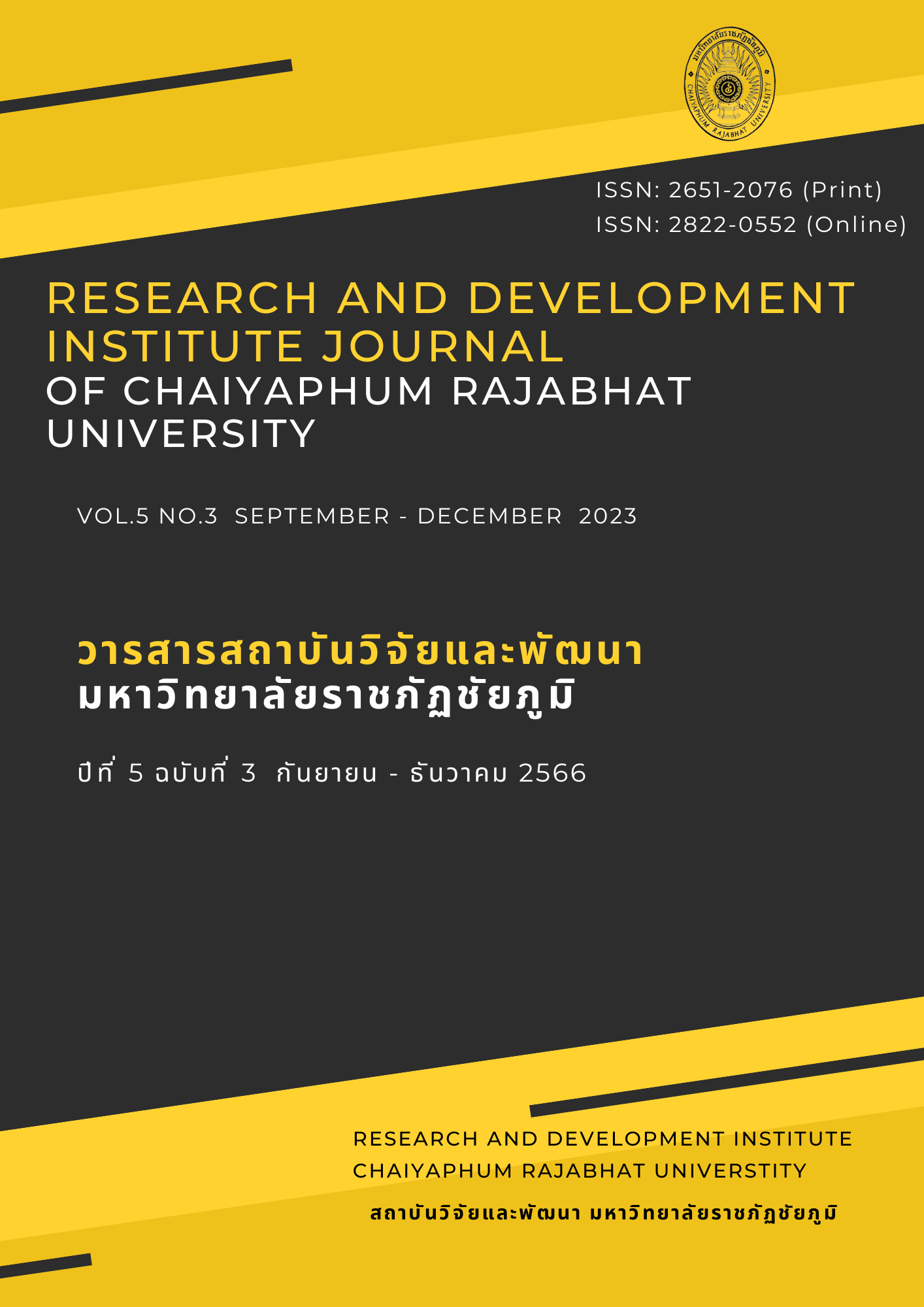Development of Social Studies Religion & Culture Grade 6 Using Comic Books to Teach a Set of Buddhist Principles
Main Article Content
Abstract
The objectives of this research were 1) to develop comic books for teaching. Set of Buddhist principles Social Studies Learning Subject Group religion and culture 2) to find the effectiveness index of learning management in the social studies learning subject group religion and culture Grade 6 by using comic books to teach set of Buddhist principles, and 3) to study the learning achievement before and after school of Social Studies Learning Subject Group religion and culture by using comic books to teach Set of Buddhist principles. The target group used in the research were Prathomsuksa 6 students at Nafaiwittaya School, Chaiyaphum Primary Educational Service Area Office, Region 1, Academic Year 2023, total of 21 students obtained by purposive sampling. The research tools consisted of 1) 12 plans of learning management plans for the social studies learning subject group, religion and culture Learning Unit 2 Principles of Buddhism Grade 6 2) Comic books for instruction which are the set of 12 Buddhist principles: Ariyasacca , Iddhipāda, the five precepts (benjasīn), the five dharma, the 6 causes of ruin (Apāyamukhas), Faith ( Saddha), virtues or attributes of the Buddha (Buddhaguna), the Threefold Training (3 Sikkhās), Four sublime states of mind (Brahmavihara), bases of sympathy (Sangahavatthu), virtues for a good household life (Gharavasa-Dhammas) , unwholsome roots (Akusala-måla) . 3) Religion and culture Substance 1 Religion, morality, ethics Unit 2 Buddhist principles Grade 6 was a multiple-choice type, with 4 options, 30 items, with Index of Item-Objective Congruence (IOC) ranging from 0.67-1.00, difficulty (P) ranging from 0.50-0.80 and discriminating power (r) ranging from 0.40-0.76 and with confidence for the whole paper equal to 0.85 The statistics used were mean, standard deviation, percentage.
The results of the study showed that:
- Comic books for teaching Set of Buddhist principles Social Studies Learning Subject Group religion and culture Grade 6 has an efficiency of 87.73/80.95 which is according to the criteria 80/80 threshold set.
- Effectiveness index of learning management Social Studies Learning Subject Group Religion and culture class Elementary school 6 by using comic books to teach. Set of Buddhist principles The effectiveness index was 0.6471, indicating that students' knowledge increased 64.71 percent.
- Students who learn by using comic books for teaching Set of Buddhist Principles with successful results 46.03 percent before and 80.95 percent after school, indicating that students' achievement after school was higher than before. representing 34.92 percent
Article Details

This work is licensed under a Creative Commons Attribution-NonCommercial-NoDerivatives 4.0 International License.
Permission to use text, content, images, etc. of publication. Any user to read, download, copy, distribute, print, search, or link to the full texts of articles, crawl them for indexing, pass them as data to software, or use them for any other lawful purpose. But do not use it for commercial use or with the intent to benefit any business. Published under a Creative Commons Attribution-NonCommercial-NoDerivatives 4.0 International License.

This work is licensed under a Creative Commons Attribution-NonCommercial-NoDerivatives 4.0 International License
References
กระทรวงศึกษาธิการ. (2551). หลักสูตรแกนกลางการศึกษาขั้นพื้นฐาน พุทธศักราช 2551. กรุงเทพฯ: โรงพิมพ์ชุมนุมสหกรณ์การเกษตรแห่งประเทศไทย จำกัด.
จินตนา ใบกาซูยี. (2534). แนวการจัดทำหนังสือสำหรับเด็ก. กรุงเทพ ฯ: โรงพิมพ์คุรุสภา.
ธนบัตร อ่อนกล. (2564). ผลการจัดการเรียนรู้แบบร่วมมือร่วมกับหนังสือการ์ตูนเรื่อง รุ่งอรุณแห่งความสุข ณ สุโขทัย กลุ่มสาระการเรียนรู้สังคมศึกษา ศาสนาและวัฒนธรรม สำหรับนักเรียนชั้นประถมศึกษาปีที่ 4. [วิทยานิพนธ์ปริญญามหาบัณฑิต]. มหาวิทยาลัยราชภัฏอุตรดิตถ์.
บรรพตี วงษ์พรพันธุ์. (2560). การพัฒนาหนังสือการ์ตูนประกอบเรื่องร่วมกับเทคนิคการแข่งขันแบบร่วมมือสำหรับนักเรียนชั้นประถมศึกษาปีที่ 1. [วิทยานิพนธ์ปริญญามหาบัณฑิต]. มหาวิทยาลัยรามคำแหง.
บุญชม ศรีสะอาด. (2546). การวิจัยสำหรับครู. กรุงเทพฯ: โรงพิมพ์สุรีวิยาสาส์น.
พระราชบัญญัติการศึกษาแห่งชาติ พ.ศ. 2542. (2542). ราชกิจจานุเบกษา. เล่ม 116 ตอนที่ 74 ก. หน้า 3.
พวงรัตน์ ทวีรัตน์. (2536). วิธีการวิจัยทางพฤติกรรมศาสตร์และสังคมศาสตร์ (พิมพ์ครั้งที่ 5). กรุงเทพฯ: สำนักทดสอบทางการศึกษาและจิตวิทยา, มหาวิทยาลัยศรีนครินทรวิโรฒ ประสานมิตร.
โรงเรียนบ้านนาฝายวิทยา. (2565). หลักสูตรสถานศึกษาโรงเรียนบ้านนาฝายวิทยา. ชัยภูมิ: สำนักงานเขตพื้นที่การศึกษาประถมศึกษาชัยภูมิ เขต 1, ชัยภูมิ.
ศักดิ์ชัย เกียรตินาคินทร์. (2534). การ์ตูน ศาสตร์และศิลป์แห่งจิตนาการ. ใน การส่งเสริมและพัฒนาหนังสือการ์ตูนไทย. กรุงเทพฯ : ศูนย์พัฒนาหนังสือกรมวิชาการ.
สมนึก ภัททิยธนี. (2549). การวัดผลการศึกษา. กาฬสินธุ์ : ประสานการพิมพ์.
สุนทรี คุณา. (2558). การศึกษาการสร้างหนังสือการ์ตูนเสริมประสบการณ์ ชุดวิถีชีวิตล้านนา สำหรับนักเรียน ภาษาไทยแบบข้ามวัฒนธรรม ระดับประถมศึกษาปีที่ 6. [วิทยานิพนธ์ปริญญามหาบัณฑิต]. มหาวิทยาลัยราชภัฏเชียงใหม่.
อมรรัตน์ เกษมรัตนพร. (2558). การสร้างหนังสือการ์ตูนคุณธรรม สำหรับนักเรียน ชั้นประถมศึกษาปีที่ 2. [การศึกษาค้นคว้าอิสระปริญญามหาบัณฑิต]. บัณฑิตวิทยาลัย, มหาวิทยาลัยเชียงใหม่.
อารี พันธ์มณี. (2546). จิตวิทยาสร้างสรรค์การเรียนการสอน. กรุงเทพมหานคร: ใยใหมครีเอทีฟ กรุ๊ป.
อเนก รัตน์ปิยะภากรณ์. (2534). การเขียนหนังสือการ์ตูนเรื่อง. ใน การส่งเสริมและพัฒนาหนังสือการ์ตูนไทย. กรุงเทพฯ: โรงพิมพ์กรมการศาสนา.


